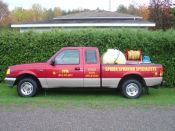
Bald Faced Hornet
Bald Faced Hornets can be found throughout Ontario. Bald faced hornets are common in both wooded and urban areas. Queens start a new nest each spring after the weather warms up in late April or May. The queen finds loose bark, and other paper strips to start a small nest into which she places her eggs. She adds saliva to the paper bark and forms a smooth nest.
Inside the nest are horizontal layers of comb divided into circular platforms. The outer nest shell is very thin. This means that if this nest is accidentally damaged from the outside, the paper covering is easily stripped away and a large number of wasps can attack and sting unwelcome intruders. Since the sting is not barbed, a single hornet can deliver a series of painful stings. It is the venom in the sting that is the cause of the pain. If you get stung, the best response is to distance oneself from the hornet nest as quickly as possible. Since there is always a danger from anaphylactic shock from the venom of a hornet, it is good policy to leave pest control to the professionals. Try to find hornet nests as soon as possible in the spring and summer because they only become larger and more aggressive with time.
Bald faced hornets are black and white, heavy bodied wasps reaching up to 25mm long. They usually build exposed, grey nests in trees or shrubs. Occasionally, they will build nests under roof overhangs, in attics, crawlspaces and wall voids, or under decks or porches. The nests are constructed of a paper like material formed from chewed wood, and may exceed the size of a basketball.
In the spring the queen emerges and builds a small nest consisting of a few paper cells. She the lays one egg in each cell, when the eggs hatch the female hunts other insects to feed to the larvae. When larvae are fully grown, they spin silk cocoons inside their cells and pupate into adult wasps. The wasps that emerge from the cells are all sterile female workers, which then take over nest building and foraging duties.
Near the end of the summer, female larvae are fed greater amounts of food, which allows them to develop into queens, with complete reproductive systems. At the same time, the queen lays unfertilized eggs, which develop into male wasps. The males mate with the fertile females, and the colony breaks up with the onset of autumn. The fertilized females over winter behind the bark of trees and the males die.
Please call us to book in for the 2025 wasp control season or call us for a free, over the phone, wasp control estimate.
- Phone (613) 966-4444
- Cellular (613) 813-3816
- Toll Free1-888-813-3816
** We also do Spiders, Flies, Ants, Earwigs, Beetles, Box Elder Bugs, Asian Ladybugs, Sow Bugs, Pill Bugs, Bedbugs, Cockroaches, Fleas, Silverfish, Termites, All Other Insects, Wildlife, Bats, Rats, Mice and much more **
We are certified by the Ministry of The Environment and fully licensed and insured.
- Belleville
- Trenton
- Brighton
- Carrying Place
- Consecon
- Wellington
- Bloomfield
- Picton
- Ameliasburg
- Demorestville
- Frankford
- Stirling
- Tweed
- Madoc
- Bayside
- Foxboro
- Smithfield
- Wooler
- Cobourg
- Colborne
- Campbellford
- Kingston
- Deseronto
- Napanee
- Stone Mills
- Tamworth
- Inverary
- Quinte West
- Northumberland
- Prince Edward County
- Hastings
- Stirling Rawdom
- Trent Hills
- Thurlow
- Centre Hastings
- Camden East
- Frontenac
- Lennox and Addington
- City of Belleville
- City of Kingston
- City of Prince Edward County
- City of Quinte West
- Town of Cobourg
- Town of Napanee
- Town of Madoc
- Town of Brighton
- Town of Bancroft
- Town of Cobourg
- Town of Deseronto
- Town of Greater Napanee
- Town of Trenton
- Town of Frankford
- Township of Centre Hastings
- Township of Loyalist
- Township of Stone Mills
- Township of Addington Highlands
- Township of Madoc
- Township of Alnwick / Haldimand
- Township of Cramahe
- Township of Faraday
- Municipality of Brighton
- Municipality of Marmora
- Municipality of Trent Hills
- Municipality of Hastings Highlands
- Municipality of Marmora
- Municipality of Tweed
- County of Hastings
- County of Northumberland
- County of Lennox and Addington
- City of Belleville
- City of Kingston
- City of Prince Edward County
- City of Quinte West

